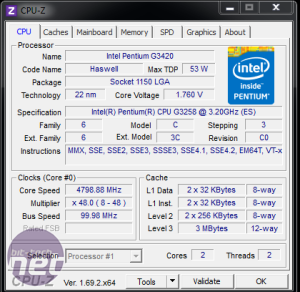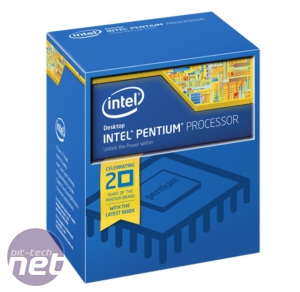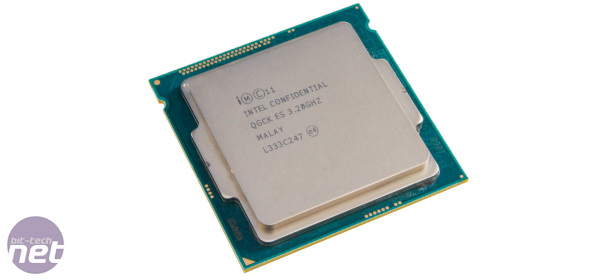Overclocking
 The Pentium G3258 retails for a fairly typical price for one of Intel's budget CPUs but its overclocking potential is the key to whether it remains just a run-of-the-mill product or an absolutely stunning bargain buy. We set our sights at 4.5GHz having seen early reports a few weeks ago of retails hitting this mark and we should also note that we had no issues setting our RAM to run at our usual 1,600MHz, despite the Pentium apparently supporting up to 1,333MHz.
The Pentium G3258 retails for a fairly typical price for one of Intel's budget CPUs but its overclocking potential is the key to whether it remains just a run-of-the-mill product or an absolutely stunning bargain buy. We set our sights at 4.5GHz having seen early reports a few weeks ago of retails hitting this mark and we should also note that we had no issues setting our RAM to run at our usual 1,600MHz, despite the Pentium apparently supporting up to 1,333MHz.We applied 1.3V vcore and all was well - nothing flagged in Prime95, so we bumped up the clock speed. We got to 4.6GHz but 4.7GHz resulted in a blue screen after 10 minutes so we headed back into the BIOS to push the voltage up a bit. We finally saw stability at 1.37V and we even managed to push the CPU one notch higher on the multiplier too, with this 3.2GHz CPU now sitting at a very impressive 4.8GHz.
This is an increase of 50 per cent - a far bigger increase than we've managed with its K-series sibling, the Core i7-4790K or either of the original Haswell Core i5 and Core i7 CPUs. Despite the pretty hefty voltage, temperatures sat at 78°C using Prime95, with an ambient room temperature of 24°C making this a delta T of 54°C while using a Corsair H80i. Clearly, you'd be within your rights to hope for pretty good overclocks even with a half decent air cooler, which is awesome news.
Performance Analysis
There's a familiar story in our benchmarks with the Pentium G3258 having the edge over AMDs CPUs, which all sport more cores, but only in single-threaded applications. At stock speed, the image editing test saw it post a score 70 per cent faster than the FX-8350, for example, and it also matched the likes of the Core i7-2600K while bettering Ivy Bridge and Sandy Bridge-based Core i3's on test too although the more recent Core i3-4130 was a little faster.
As soon as we switch to rendering and video encoding, though, the Pentium struggles. It was slowest in our video encoding test where even AMDs APUs performed much better thanks to their additional CPU cores. It was also slowest in both Cinebench tests and in the Shogun 2: Total War CPU benchmark, although The Elder Scrolls: Skyrim saw it outperform the AMD FX-8350, even when the latter was overclocked. Overall in our Media Benchmarks, the Pentium G3258 scored 1,579, which is way down the table, but still faster than the AMD A10-6800K and AMD FX-8120 and only a little slower than recent Core i3's.
Now for the really important bit - overclocked results. At 4.8GHz, the image editing score skyrocketed from 1,705 to 2,469. this was enough to better all other CPU results at stock speed and it even picked off the second best overclocked result too, which was the Core i7-4770K at 4.7GHz. Only the Core i7-4790K at 4.8GHz was faster.
The video encoding test saw an even bigger improvement, screaming all the way from 1,810 to 2,775. This was enough to better all the AMD CPUs and Intel Core i3's at stock speeds, but even the FX-8120 was faster once overclocked thanks to its additional CPU cores. Overall, its score of 2,208 at 4.8GHz was enough to pip all the AMD and Intel Core i3 CPUs - a fantastic result from a sub £60 CPU. The only way you'd get anything faster is a K-series Intel CPU.
In games, the lack of cores still resulted in slightly off-the-pace scores although again the result was enough to see off the FX-8350 and Core i3-4130 by a noticeable margin in The Elder Scrolls: Skyrim. The Shogun 2: Total War CPU Test is also a good indicator of raw CPU power and while the Pentium once again bettered the AMD CPUs and Core i3-4130, the recent K-series and all the overclocked K-series CPUs were much faster.
Finally Cinebench, and it's pretty clear here that if you'll be doing any rendering work, the Pentium G3258 should be avoided, even at 4.8GHz. If you're looking for a budget CPU for regular rendering, then AMD is your best bet although the A10-6800K was just as slow. We'll end on a high, though, as power consumption is epically low and even overclocked, our system as a whole drew just 112W from the wall. This is a third as much as an overclocked AMD FX-8350 - 112W compared to 334W and a huge amount less than the K-series CPUs too.
Click to enlarge
Conclusion
The Pentium G3258 is absolutely awesome. However, its recommendation isn't unequivocal. It only really comes into its own once overclocked, but the same can be said for AMDs CPUs too, which after all are what Intel is gunning for here. Its multi-threaded performance is pretty dire so if you'll be doing any rendering or video encoding work, it is to be avoided. However, in both our game tests, the case for more cores is always better doesn't hold up - both tests respond well to raw CPU grunt and Intel's K-series CPUs do well as a result. This may well differ in games that regularly make use of more than two cores, but of course, these cores will never be loaded as much as they are in rendering or encoding, so the Pentium's disadvantage won't be as large for a start.Once overclocked, the Pentium G3258 really did give the AMD CPUs a run for their money, despite only having two CPU cores, bettering them in both game benchmarks, although it still exhibited some CPU bottlenecking with our high-end graphics card. In situations with few threads on the go, such as image editing, Intel's better clock-for-clock performance means the Pentium G3258 is faster at stock speed and miles ahead once overclocked than the likes of the FX-8350 too.
So the big question is price - is a Pentium G3258 or AMD FX system better value? At £55, the cost of tapping into overclocking with an accompanying Z97 motherboard is in the region of £120, given the latter can be had for around £70. It would be impossible to build an AMD FX-8320-based system for the same price, as the CPU alone retails for over £100, and even the FX-6300 you'd be looking for a similar amount to the Pentium G3258 overall if you want a half-decent board. To add to AMD's headache, Asus has announced that via a BIOS update, its cheaper H87, H97, B85 and H81 motherboards will be able to tap into multiplier control too, which could bring the price down even further.
So Intel has certainly shaken things up in the low end and given AMD something to think about. The Pentium G3258 has an extremely low power draw too, even once overclocked with the only caveats being poor multi-threaded performance - this didn't seem to impact too much on our game tests although they're obviously a small selection. Whether you want to go for a Z97 board but can't afford a K-series CPU right now, or you just want a cheap but powerful gaming system, the Pentium G3258 is an excellent choice - so long as you're up for some fairly easy overclocking and won't be doing much rendering or video encoding.

-
Speed39 / 50
-
Features12 / 15
-
Value33 / 35


MSI MPG Velox 100R Chassis Review
October 14 2021 | 15:04











Want to comment? Please log in.